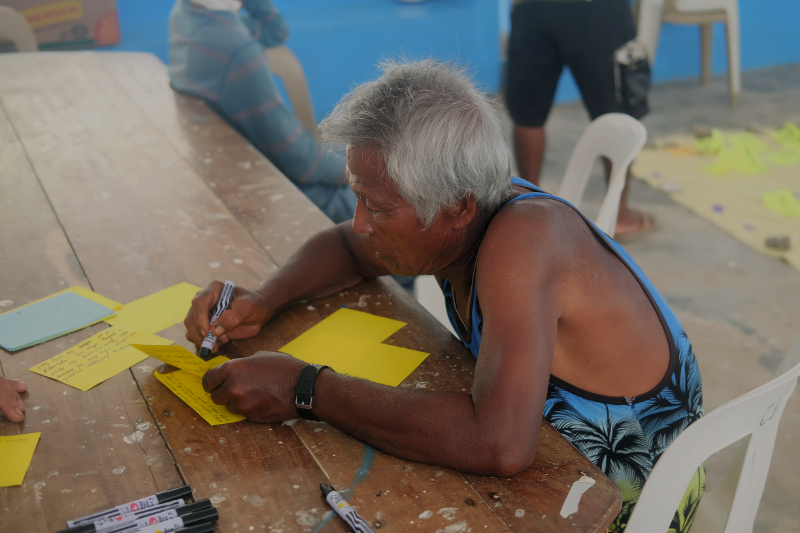Indigenous stewards of sacred marine areas

Indigenous youth fishing within their ancestral territory. Credit - C3 Philippines
Pivoting towards an Indigenous-centric approach to conservation
Protected areas have historically brought unintended consequences for Indigenous Peoples, often marginalising them further within society. Across various countries, Indigenous communities have been displaced from their lands and waters to facilitate area-based conservation efforts. In Palawan, Philippines, several protected areas established within ancestral territories have sparked opposition from Indigenous Peoples. Among them are the Calamian Tagbanwa, a sea-based Indigenous group from the northern part of Palawan Island and the Calamianes Group of Islands. Key concerns voiced by these communities include inadequate consultation, violations of their territorial rights, and insufficient representation in management bodies overseeing these protected areas.

Community Centred Conservation (C3) Philippines is a grassroots, non-governmental organisation with a long-running history of working with local communities in Palawan. Under the project "Replicating a Successful Model to Develop a Network of Indigenous Marine Managed Areas," C3 Philippines worked closely with and for the Calamian Tagbanwa. The initiative aimed to bolster local food security while preserving Indigenous customs and traditions through the establishment of Indigenous Marine Managed Areas (IMMAs) across six villages, all within the ancestral territories of the Calamian Tagbanwa.
C3 Philippines pivoted away from the more common and widely used approach towards an Indigenous-centric one for the project. Initially conceived as community-managed Marine Protected Areas with conventional regulatory frameworks like zoning policies, IMMAs have evolved to more fully integrate Indigenous perspectives. This shift has resulted in the establishment of IMMAs tailored specifically to the needs and aspirations of the Calamian Tagbanwa communities. Today, IMMAs represent areas within ancestral waters and coasts voluntarily designated by the Calamian Tagbanwa and managed according to their own governance and stewardship principles.

Central to C3 Philippines' strategy is a strong commitment to uphold Indigenous rights, including their rights to self-determination, participation and consultation, and self-governance. In collaboration with the Philippines' National Commission on Indigenous Peoples, C3 Philippines ensured that all initiatives are implemented with the free, prior, and informed consent of the communities involved. The process of establishing IMMAs was also conducted respectfully through deliberate participatory methods involving all community segments: women, men, youth, and elders. A similar inclusive and participatory approach became crucial in developing management plans that do not only reflect each community's aspirations but also integrate their invaluable traditional ecological knowledge in marine resource management.
Over 1,000 ha of IMMAs have been established throughout Palawan. These areas encompass vital ecosystems such as mangrove forests, sandy beaches, rocky intertidal zones, seagrass beds, and both mesophotic and shallow water coral reefs. They provide habitats for a diverse array of species, including globally threatened dugongs and sea turtles. To add, these IMMAs include traditional fishing grounds and sacred sites deeply intertwined with the cultural heritage and traditions of the Calamian Tagbanwa. Despite their ecological and cultural significance, these areas are under considerable threat from human activities such as dynamite and sodium cyanide fishing, commercial seine fishing, and various development projects.

For the Calamian Tagbanwa, the environment and culture are inseparable. Conserving the IMMAs is not just about protecting biodiversity – it is about revitalising Calamian Tagbanwa culture and traditions. During a community consultation facilitated by C3 Philippines, Redempto Pulilan, an Indigenous leader from one of the six villages, emphasised the link between cultural decline and environmental degradation. He lamented, “In the past, these sacred areas [now part of IMMAs] were revered. Nowadays, they are not respected, leading people to destroy stones, mangroves, and the environment. It's like stripping away their significance. Together, let's strive to restore respect for these sacred places and restore them to their original state. Let's take care of them.”
Similarly, the Calamian Tagbanwa from an adjacent village called Malawig underscored in their management plan their aspiration in restoring their environment and culture. They wrote, “We dream to see our environment's abundance and our culture and tradition restored for the present and future generations of Calamian Tagbanwa." The implementation of the management plans are expected to start later in the year.
Moving forward, C3 Philippines remains dedicated to backing IMMAs and the broader aspirations of the Calamian Tagbanwa. Beyond the physical boundaries of IMMAs, C3 Philippines recognises the significance of the relationships built with the Calamian Tagbanwa in the last years. These collaborations extend beyond project timelines and objectives, and shall persist to better amplify Indigenous stewardship within ancestral territories for present and future generations.

Written by Igna G. Salvador, Reynante V. Ramilo. For more information on this Darwin Initiative Main project 29-026, led by C3 Philippines Inc, please click here.



 Back
Back